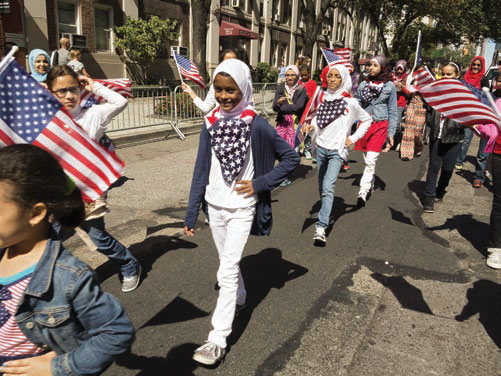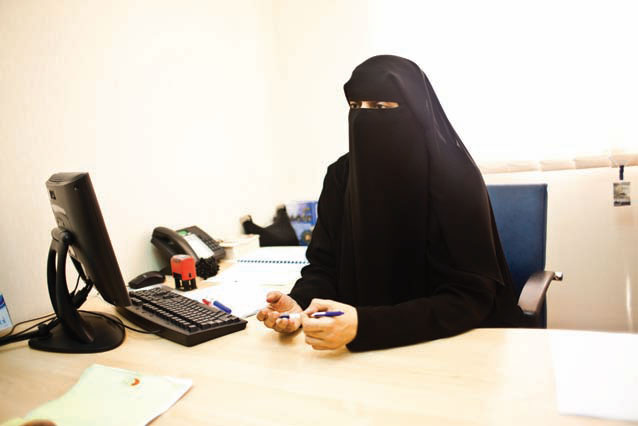8.4
Us Versus Them: Group Identity
Just who do you think you are? That's not a challenge or an insult, but rather a primary question that social psychologists address. Defining who we are is often an exercise in examining the people we associate with, how they define themselves, and what impact that process has on us. In this section, we examine these issues, starting with our social and ethnic identities.
Ethnic Identity
Each of us develops a personal identity that is based on our particular traits and unique life history. But we also develop social identities based on the groups we belong to, including our national, religious, political, and occupational groups (Abrams, 2015; Tajfel & Turner, 1986). In multicultural societies such as the United States and Canada, different social identities sometimes collide. In particular, people often face the dilemma of balancing an ethnic identity, a close identification with a religious or ethnic group, and acculturation, identification with the dominant culture (Phinney, 2006). The hallmarks of having an ethnic identity are that you identify with the group, feel proud to be a member, feel emotionally attached to the group, and behave in ways that conform to the group's rules, values, and norms.
Many Americans today do not want to be pigeonholed into one ethnic or racial category. Some have created combination identities, such as Blaxican (African American and Mexican), Negripino (African American and Filipino), and Chino-Latino (Chinese and Hispanic). In the 2010 U.S. Census, nearly half of all Latinos identified themselves as belonging to an ethnic group but refused to respond to what “race” they belong to, saying they are too mixed to choose one; Latinos are in fact overwhelmingly blended with Indian, European, African, and other racial categories. The blurring of traditional ethnic and racial boundaries is likely to continue: In 2010, nearly 15 percent of all new marriages in the United States were interracial, more than double what the number was in 1980 (6.7 percent).
Of course, most minorities remain identified with their ethnicity of origin, while picking and choosing among the values, foods, and customs of the mainstream culture. However, acculturation is not always easy, in any nation. Many immigrants arrive in their host country with every intention of becoming part of the mainstream culture. If they encounter discrimination or other setbacks, however, they may realize that acculturation is harder than they anticipated and that their original ethnic identity offers greater solace; this is why new immigrants often have poorer health in response to the stresses of trying to acculturate than their children do (Schwartz et al., 2010). There seems to be a critical period for successful acculturation: People become better able to identify with their host culture the longer they are exposed to it, but, as a study of Chinese immigrants in Canada found, often only if that exposure occurs when they are relatively young (Cheung, Chudek, & Heine, 2011).

Do you have an ethnic identity? If you are a member of an ethnic minority within your country, city, or college, how acculturated do you feel? Do you feel at ease in more than one culture, or only in your own? Does your comfort level depend on the situation you’re in? Now ask five friends, relatives, or acquaintances, ideally from different ethnic groups, how they would answer these questions. If you feel that you do not have an ethnic heritage other than a national identity, why is that? Would your parents and grandparents feel the same as you do?
Ethnocentrism
Social identities give us a sense of place and position in the world. Without them, most of us would feel like loose marbles rolling around in an unconnected universe. It feels good to be part of an “us.” But does that mean that we must automatically feel superior to “them”?
Ethnocentrism is the belief that your own culture, nation, or religion is superior to all others. Ethnocentrism is universal, probably because it aids survival by increasing people's attachment to their own group and their willingness to work on its behalf. It is even embedded in some languages: The Chinese word for China means “the center of the world” (consigning the other 6 billion people to the suburbs?) and the Navajo, the Kiowa, and the Inuit call themselves simply “The People.” Social identities can exert a powerful influence on our lives, as the video Under the Influence of Others 2 discusses.
Watch
Under the Influence of Others 2
Ethnocentrism rests on a fundamental social identity: us. As soon as people have created a category called “us,” however, they invariably perceive everybody else as “not-us.” This in-group solidarity can be manufactured in a minute in a laboratory, as Henri Tajfel and his colleagues (1971) demonstrated in an experiment with British schoolboys. Tajfel showed the boys slides with varying numbers of dots on them and asked the boys to guess how many dots there were. The boys were arbitrarily told that they were “overestimators” or “underestimators” and were then asked to work on another task. In this phase, they had a chance to give points to other boys identified as overestimators or underestimators. Although each boy worked alone in his cubicle, almost every single one assigned far more points to boys he thought were like him, an overestimator or an underestimator. As the boys emerged from their rooms, they were asked, “Which were you?” The answers received either cheers or boos from the others.
Us–them social identities are strengthened when two groups compete with each other. Years ago, Muzafer Sherif and his colleagues used a natural setting, a Boy Scout camp called Robbers Cave, to demonstrate the effects of competition on hostility and conflict between groups (Sherif, 1958; Sherif et al., 1961). Sherif randomly assigned 11- and 12-year-old boys to two groups, the Eagles and the Rattlers. To build a sense of in-group identity and team spirit, he had each group work together on projects such as making a rope bridge and building a diving board. Sherif then put the Eagles and Rattlers in competition for prizes. During fierce games of football, baseball, and tug-of-war, the boys whipped up a competitive fever that soon spilled off the playing fields. They began to raid each other's cabins, call each other names, and start fistfights. No one dared to have a friend from the rival group. Before long, the Eagles and the Rattlers were as hostile toward each other as any two gangs fighting for turf. Their hostility continued even when they were just sitting around together watching movies.
Then Sherif decided to try to undo the hostility he had created and make peace between the Eagles and Rattlers. He and his associates set up a series of predicaments in which both groups needed to work together to reach a desired goal—for example, pooling their resources to get a movie they all wanted to see or pulling a staff truck up a hill on a camping trip. This policy of interdependence in reaching mutual goals was highly successful in reducing the boys' “ethnocentrism,” competitiveness, and hostility; the boys eventually made friends with their former enemies (see Figure8.4). Interdependence has a similar effect in adult groups (Gaertner et al., 1990). The reason, it seems, is that cooperation causes people to think of themselves as members of one big group instead of two opposed groups, us and them.
Figure 8.4
The Experiment at Robbers Cave

Stereotypes
We're going to bet you don't have a lot of experience with people from Lichtenstein, a tiny nation located in the Alps between Switzerland and Austria. At only 62 square miles and populated by only 37,000 people, it's smaller than many cities in the United States. Yet knowing just this bit about it—it's probably like Switzerland, it most likely has wealthy inhabitants, probably a majority white population—you've no doubt already formed an opinion of what typical Lichtensteinians are like. A stereotype is a summary impression of a group of people in which all members of the group are viewed as sharing a common trait or traits. People have stereotypes of drivers of Ferraris or Hondas, of engineering students and art students, of feminists and fraternity men.
Stereotypes aren't necessarily bad and they are sometimes accurate (Lee, McCauley, & Jussim, 2013). They are, as some psychologists have called them, useful tools in the mental toolbox—energy-saving devices that allow us to make efficient decisions (Macrae & Bodenhausen, 2000). They help us quickly process new information and retrieve memories. They allow us to organize experience, make sense of differences among individuals and groups, and predict how people will behave. In fact, the brain automatically registers and encodes the basic categories of gender, ethnicity, and age, suggesting that there is a neurological basis for the cognitive efficiency of stereotyping (Ito & Urland, 2003).
However, although stereotypes reflect real differences among people, they also distort that reality in three ways (Judd et al., 1995). First, they exaggerate differences between groups, making the stereotyped group seem odd, unfamiliar, or dangerous, not like “us.” Second, they produce selective perception; people tend to see only the evidence that fits the stereotype and reject any perceptions that do not fit. Third, they underestimate differences within the stereotyped group, creating the impression that all members of that group are the same.

What is this woman’s occupation? Among non-Muslims in the West, the assumption is that Muslim women who wear the full-length black niqab must be repressed sexually as well as politically. But the answer shatters the stereotype. Wedad Lootah, a Muslim living in Dubai, United Arab Emirates, is a marriage counselor and sexual activist, author of a best-selling Arabic book, Top Secret: Sexual Guidance for Married Couples. She wrote it, she says, because of a 52-year-old client who had many children but had never experienced sexual pleasure with her husband. “Finally, she discovered orgasm!” Ms. Lootah reported. “Imagine, all that time she did not know.”
Cultural values affect how people evaluate the actions of another group and whether a stereotype becomes positive or negative. Chinese students in Hong Kong, where communalism and respect for elders are valued, think that a student who comes late to class or argues with a parent about grades is being selfish and disrespectful of adults. But Australian students, who value individualism, think that the same behavior is perfectly appropriate (Forgas & Bond, 1985). You can see how the Chinese might form negative stereotypes of “disrespectful” Australians, and how the Australians might form negative stereotypes of the “spineless” Chinese. Unfortunately, it's a small step from stereotypical thinking to the formation of prejudicial attitudes to the enactment of discriminatory behavior. In the next section we will examine how prejudice develops, how scientists can measure it, and what can be done to reduce it. Before we address those topics, take a look at the video Are Stereotypes and Prejudice Inevitable? for perspectives on this aspect of social behavior.
Watch
Are Stereotypes and Prejudice Inevitable?